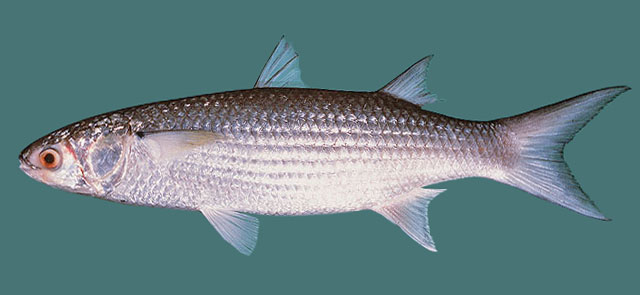|
Moolgarda seheli (Fabricius, 1775) Bluespot mullet |

|
|
photo by
Randall, J.E. |
| Family: | Mugilidae (Mullets) | |||
| Max. size: | 60 cm TL (male/unsexed); max.weight: 8,000.0 g | |||
| Environment: | reef-associated; freshwater; brackish; marine; depth range 0 - 3 m, catadromous | |||
| Distribution: | Indo-Pacific: Red Sea, south to Transkei, South Africa (Ref. 4393) and east to the Hawaiian and Marquesan islands, north to southern Japan, south to New Caledonia and Norfolk Island (Ref. 8879) and Tuamotu Islands (Ref. 90102). | |||
| Diagnosis: |
Dorsal spines (total): 5-5; Dorsal soft rays (total): 8-9; Anal spines: 3-3; Anal soft rays: 9-9. Diagnosis: Characterized by having membranous, digitate posterior margin on scales; snout shorter than eye diameter; slender maxilla and weakly curved ventrally at posterior tip, partially or completely concealed; poorly developed adipose eyelid as rim around eye; preorbital weakly concave on anteroventral edge (Ref. 90102). Description: No teeth in lips or on palatines, but vomer and tongue dentate; preorbital margin scaly, bent, the notch and serrations become obscured with growth (Ref. 4393). First dorsal fin with 4 spines, second dorsal fin with 1 spine and 8 soft rays; anal fin with 3 spines and 9 soft rays; pectoral fin with 18 rays (Ref. 4393). Scales on lateral line 38-42; scaly process at 1st dorsal fin base 4.2-5.0 times in predorsal distance; pectoral axillary scale 3.2 times in ead length (Ref. 4393, 4967). Colouration: Bluish brown or green dorsally; flanks and abdomen silvery; dusky spots on upper row of scales, giving indistinct longitudinal stripes (Ref. 9812). Dorsal and upper lobe of caudal fin with dark-blue tip; anal, pelvic, and pectoral fins yellow; pectoral fins also with dark blue spot dorsally at origin (Ref. 9812). |
|||
| Biology: | Found in coastal waters but enters estuaries and rivers where they feed on microalgae, filamentous algae, forams, diatoms, and detritus associated with sand and mud (Ref. 9812). Form schools. Oviparous, eggs are pelagic and non-adhesive (Ref. 205). Also caught using stakenets, barrier nets, and pouch nets during spawning; also taken as bycatch (Ref. 9812). Marketed fresh and perhaps salted, boiled (Thailand), canned or frozen (Australia); roe salted (Ref. 9812). | |||
| IUCN Red List Status: | Least Concern (LC); Date assessed: 02 June 2020 Ref. (130435) | |||
| Threat to humans: | harmless | |||